Financial Management: Analyzing & Improving Financial Performance
VerifiedAdded on 2023/06/18
|13
|2664
|446
Report
AI Summary
This report provides a comprehensive analysis of financial management principles, emphasizing the importance of managing assets, liabilities, expenses, and incomes to maximize profits. It delves into key financial statements such as the income statement, balance sheet, and cash flow statement, highlighting their role in assessing a firm's financial health. The report also examines the application of accounting ratios, including profitability, liquidity, and efficiency ratios, in evaluating a company's performance, using provided data to illustrate these concepts. Furthermore, it discusses strategies for improving financial performance, such as recovering outstanding debt, rearranging expenses, and disposing of non-performing assets. The analysis concludes that effective financial management is crucial for achieving business goals and enhancing overall performance, and by leveraging platforms like Desklib, students can access valuable resources like past papers and solved assignments to deepen their understanding.

Financial
Management
Management
Paraphrase This Document
Need a fresh take? Get an instant paraphrase of this document with our AI Paraphraser
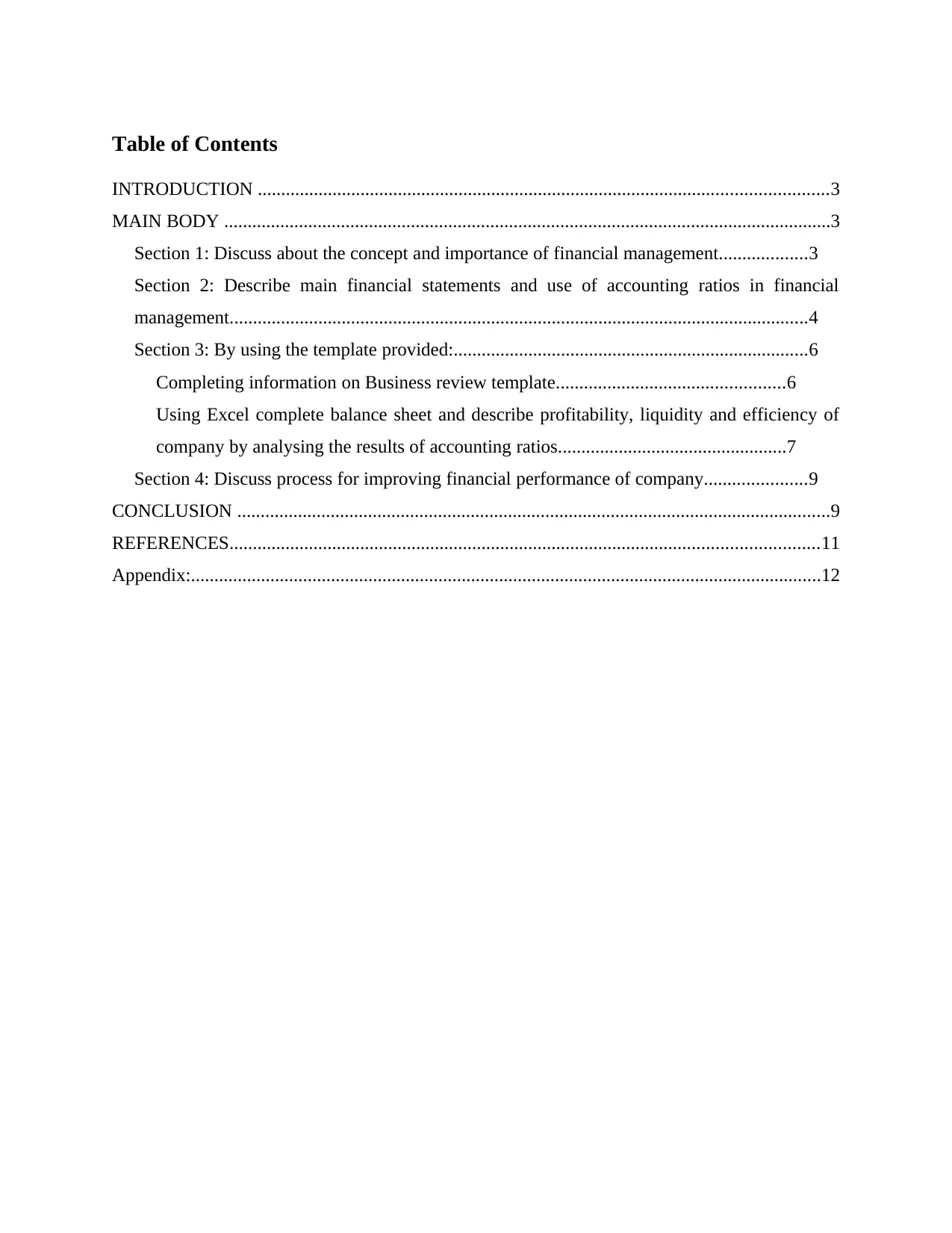
Table of Contents
INTRODUCTION ..........................................................................................................................3
MAIN BODY ..................................................................................................................................3
Section 1: Discuss about the concept and importance of financial management...................3
Section 2: Describe main financial statements and use of accounting ratios in financial
management............................................................................................................................4
Section 3: By using the template provided:............................................................................6
Completing information on Business review template.................................................6
Using Excel complete balance sheet and describe profitability, liquidity and efficiency of
company by analysing the results of accounting ratios.................................................7
Section 4: Discuss process for improving financial performance of company......................9
CONCLUSION ...............................................................................................................................9
REFERENCES..............................................................................................................................11
Appendix:.......................................................................................................................................12
INTRODUCTION ..........................................................................................................................3
MAIN BODY ..................................................................................................................................3
Section 1: Discuss about the concept and importance of financial management...................3
Section 2: Describe main financial statements and use of accounting ratios in financial
management............................................................................................................................4
Section 3: By using the template provided:............................................................................6
Completing information on Business review template.................................................6
Using Excel complete balance sheet and describe profitability, liquidity and efficiency of
company by analysing the results of accounting ratios.................................................7
Section 4: Discuss process for improving financial performance of company......................9
CONCLUSION ...............................................................................................................................9
REFERENCES..............................................................................................................................11
Appendix:.......................................................................................................................................12
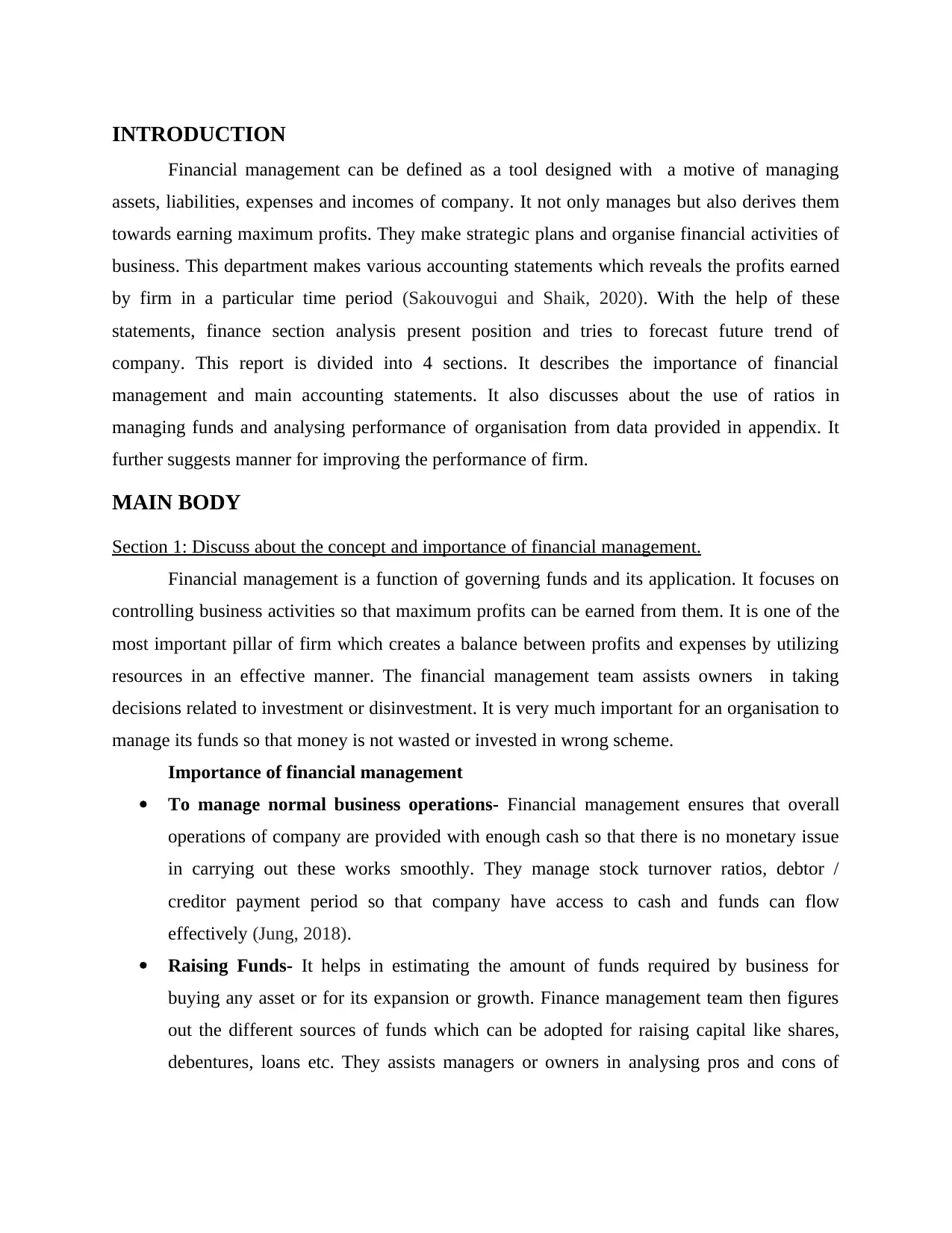
INTRODUCTION
Financial management can be defined as a tool designed with a motive of managing
assets, liabilities, expenses and incomes of company. It not only manages but also derives them
towards earning maximum profits. They make strategic plans and organise financial activities of
business. This department makes various accounting statements which reveals the profits earned
by firm in a particular time period (Sakouvogui and Shaik, 2020). With the help of these
statements, finance section analysis present position and tries to forecast future trend of
company. This report is divided into 4 sections. It describes the importance of financial
management and main accounting statements. It also discusses about the use of ratios in
managing funds and analysing performance of organisation from data provided in appendix. It
further suggests manner for improving the performance of firm.
MAIN BODY
Section 1: Discuss about the concept and importance of financial management.
Financial management is a function of governing funds and its application. It focuses on
controlling business activities so that maximum profits can be earned from them. It is one of the
most important pillar of firm which creates a balance between profits and expenses by utilizing
resources in an effective manner. The financial management team assists owners in taking
decisions related to investment or disinvestment. It is very much important for an organisation to
manage its funds so that money is not wasted or invested in wrong scheme.
Importance of financial management
To manage normal business operations- Financial management ensures that overall
operations of company are provided with enough cash so that there is no monetary issue
in carrying out these works smoothly. They manage stock turnover ratios, debtor /
creditor payment period so that company have access to cash and funds can flow
effectively (Jung, 2018).
Raising Funds- It helps in estimating the amount of funds required by business for
buying any asset or for its expansion or growth. Finance management team then figures
out the different sources of funds which can be adopted for raising capital like shares,
debentures, loans etc. They assists managers or owners in analysing pros and cons of
Financial management can be defined as a tool designed with a motive of managing
assets, liabilities, expenses and incomes of company. It not only manages but also derives them
towards earning maximum profits. They make strategic plans and organise financial activities of
business. This department makes various accounting statements which reveals the profits earned
by firm in a particular time period (Sakouvogui and Shaik, 2020). With the help of these
statements, finance section analysis present position and tries to forecast future trend of
company. This report is divided into 4 sections. It describes the importance of financial
management and main accounting statements. It also discusses about the use of ratios in
managing funds and analysing performance of organisation from data provided in appendix. It
further suggests manner for improving the performance of firm.
MAIN BODY
Section 1: Discuss about the concept and importance of financial management.
Financial management is a function of governing funds and its application. It focuses on
controlling business activities so that maximum profits can be earned from them. It is one of the
most important pillar of firm which creates a balance between profits and expenses by utilizing
resources in an effective manner. The financial management team assists owners in taking
decisions related to investment or disinvestment. It is very much important for an organisation to
manage its funds so that money is not wasted or invested in wrong scheme.
Importance of financial management
To manage normal business operations- Financial management ensures that overall
operations of company are provided with enough cash so that there is no monetary issue
in carrying out these works smoothly. They manage stock turnover ratios, debtor /
creditor payment period so that company have access to cash and funds can flow
effectively (Jung, 2018).
Raising Funds- It helps in estimating the amount of funds required by business for
buying any asset or for its expansion or growth. Finance management team then figures
out the different sources of funds which can be adopted for raising capital like shares,
debentures, loans etc. They assists managers or owners in analysing pros and cons of
⊘ This is a preview!⊘
Do you want full access?
Subscribe today to unlock all pages.

Trusted by 1+ million students worldwide
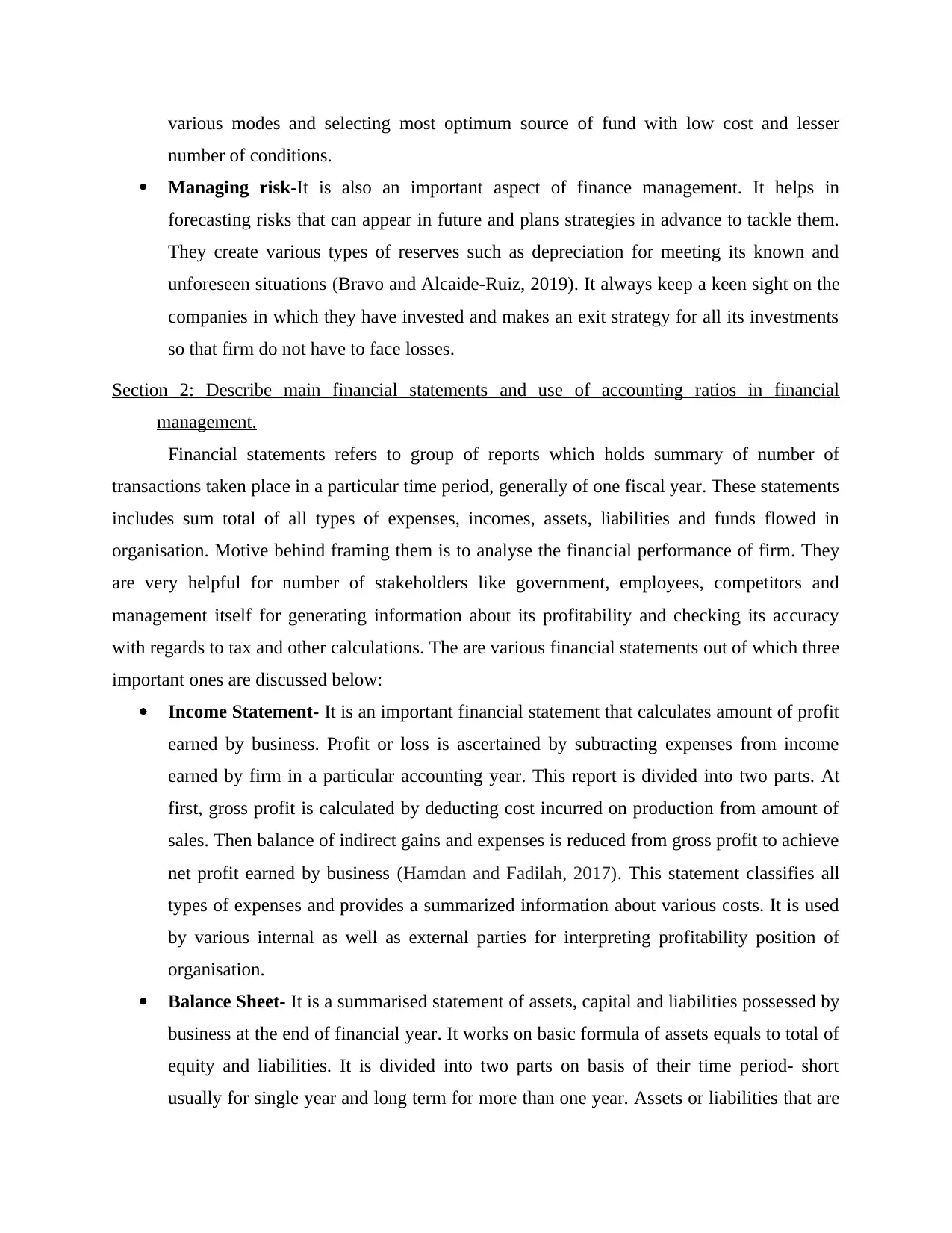
various modes and selecting most optimum source of fund with low cost and lesser
number of conditions.
Managing risk-It is also an important aspect of finance management. It helps in
forecasting risks that can appear in future and plans strategies in advance to tackle them.
They create various types of reserves such as depreciation for meeting its known and
unforeseen situations (Bravo and Alcaide-Ruiz, 2019). It always keep a keen sight on the
companies in which they have invested and makes an exit strategy for all its investments
so that firm do not have to face losses.
Section 2: Describe main financial statements and use of accounting ratios in financial
management.
Financial statements refers to group of reports which holds summary of number of
transactions taken place in a particular time period, generally of one fiscal year. These statements
includes sum total of all types of expenses, incomes, assets, liabilities and funds flowed in
organisation. Motive behind framing them is to analyse the financial performance of firm. They
are very helpful for number of stakeholders like government, employees, competitors and
management itself for generating information about its profitability and checking its accuracy
with regards to tax and other calculations. The are various financial statements out of which three
important ones are discussed below:
Income Statement- It is an important financial statement that calculates amount of profit
earned by business. Profit or loss is ascertained by subtracting expenses from income
earned by firm in a particular accounting year. This report is divided into two parts. At
first, gross profit is calculated by deducting cost incurred on production from amount of
sales. Then balance of indirect gains and expenses is reduced from gross profit to achieve
net profit earned by business (Hamdan and Fadilah, 2017). This statement classifies all
types of expenses and provides a summarized information about various costs. It is used
by various internal as well as external parties for interpreting profitability position of
organisation.
Balance Sheet- It is a summarised statement of assets, capital and liabilities possessed by
business at the end of financial year. It works on basic formula of assets equals to total of
equity and liabilities. It is divided into two parts on basis of their time period- short
usually for single year and long term for more than one year. Assets or liabilities that are
number of conditions.
Managing risk-It is also an important aspect of finance management. It helps in
forecasting risks that can appear in future and plans strategies in advance to tackle them.
They create various types of reserves such as depreciation for meeting its known and
unforeseen situations (Bravo and Alcaide-Ruiz, 2019). It always keep a keen sight on the
companies in which they have invested and makes an exit strategy for all its investments
so that firm do not have to face losses.
Section 2: Describe main financial statements and use of accounting ratios in financial
management.
Financial statements refers to group of reports which holds summary of number of
transactions taken place in a particular time period, generally of one fiscal year. These statements
includes sum total of all types of expenses, incomes, assets, liabilities and funds flowed in
organisation. Motive behind framing them is to analyse the financial performance of firm. They
are very helpful for number of stakeholders like government, employees, competitors and
management itself for generating information about its profitability and checking its accuracy
with regards to tax and other calculations. The are various financial statements out of which three
important ones are discussed below:
Income Statement- It is an important financial statement that calculates amount of profit
earned by business. Profit or loss is ascertained by subtracting expenses from income
earned by firm in a particular accounting year. This report is divided into two parts. At
first, gross profit is calculated by deducting cost incurred on production from amount of
sales. Then balance of indirect gains and expenses is reduced from gross profit to achieve
net profit earned by business (Hamdan and Fadilah, 2017). This statement classifies all
types of expenses and provides a summarized information about various costs. It is used
by various internal as well as external parties for interpreting profitability position of
organisation.
Balance Sheet- It is a summarised statement of assets, capital and liabilities possessed by
business at the end of financial year. It works on basic formula of assets equals to total of
equity and liabilities. It is divided into two parts on basis of their time period- short
usually for single year and long term for more than one year. Assets or liabilities that are
Paraphrase This Document
Need a fresh take? Get an instant paraphrase of this document with our AI Paraphraser
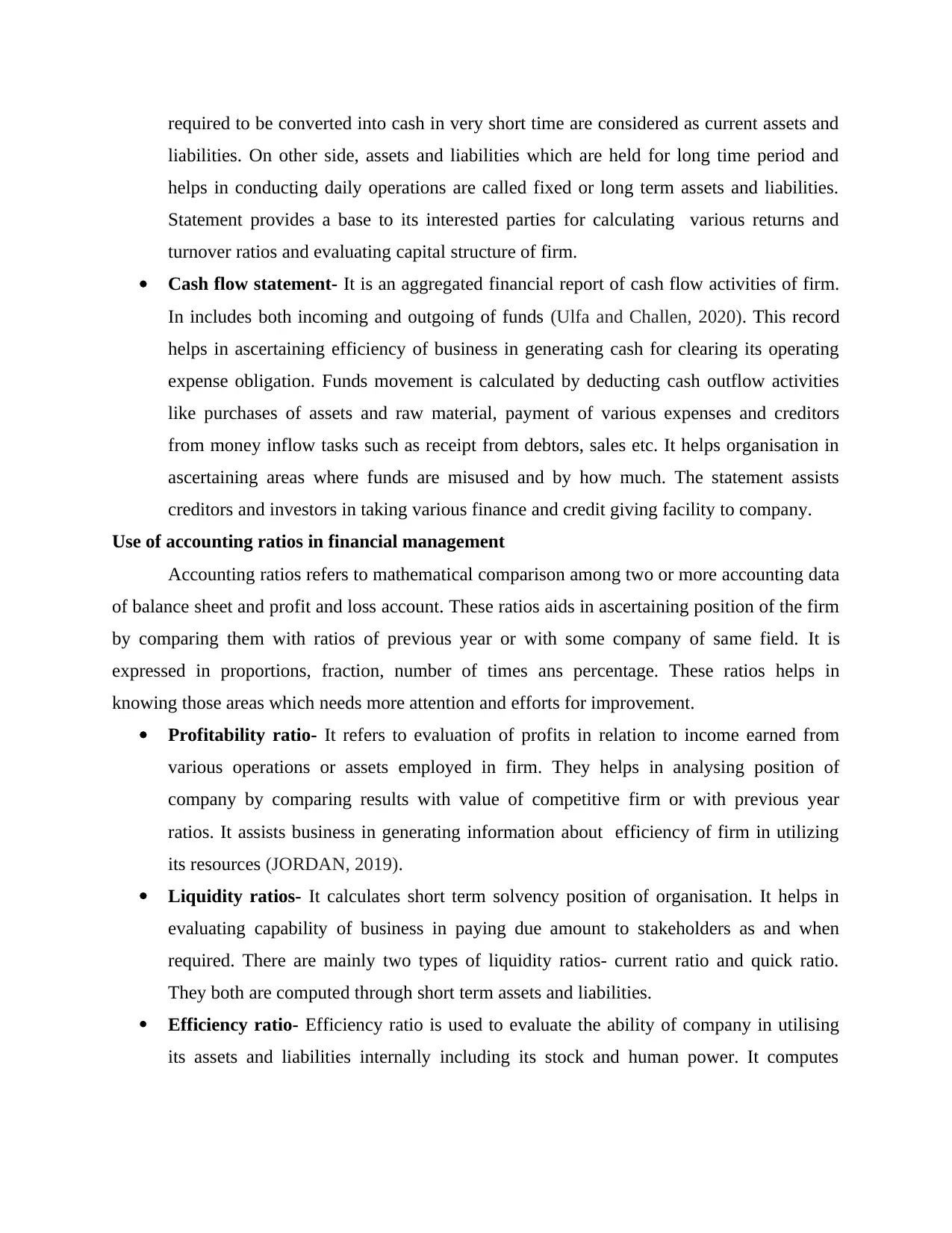
required to be converted into cash in very short time are considered as current assets and
liabilities. On other side, assets and liabilities which are held for long time period and
helps in conducting daily operations are called fixed or long term assets and liabilities.
Statement provides a base to its interested parties for calculating various returns and
turnover ratios and evaluating capital structure of firm.
Cash flow statement- It is an aggregated financial report of cash flow activities of firm.
In includes both incoming and outgoing of funds (Ulfa and Challen, 2020). This record
helps in ascertaining efficiency of business in generating cash for clearing its operating
expense obligation. Funds movement is calculated by deducting cash outflow activities
like purchases of assets and raw material, payment of various expenses and creditors
from money inflow tasks such as receipt from debtors, sales etc. It helps organisation in
ascertaining areas where funds are misused and by how much. The statement assists
creditors and investors in taking various finance and credit giving facility to company.
Use of accounting ratios in financial management
Accounting ratios refers to mathematical comparison among two or more accounting data
of balance sheet and profit and loss account. These ratios aids in ascertaining position of the firm
by comparing them with ratios of previous year or with some company of same field. It is
expressed in proportions, fraction, number of times ans percentage. These ratios helps in
knowing those areas which needs more attention and efforts for improvement.
Profitability ratio- It refers to evaluation of profits in relation to income earned from
various operations or assets employed in firm. They helps in analysing position of
company by comparing results with value of competitive firm or with previous year
ratios. It assists business in generating information about efficiency of firm in utilizing
its resources (JORDAN, 2019).
Liquidity ratios- It calculates short term solvency position of organisation. It helps in
evaluating capability of business in paying due amount to stakeholders as and when
required. There are mainly two types of liquidity ratios- current ratio and quick ratio.
They both are computed through short term assets and liabilities.
Efficiency ratio- Efficiency ratio is used to evaluate the ability of company in utilising
its assets and liabilities internally including its stock and human power. It computes
liabilities. On other side, assets and liabilities which are held for long time period and
helps in conducting daily operations are called fixed or long term assets and liabilities.
Statement provides a base to its interested parties for calculating various returns and
turnover ratios and evaluating capital structure of firm.
Cash flow statement- It is an aggregated financial report of cash flow activities of firm.
In includes both incoming and outgoing of funds (Ulfa and Challen, 2020). This record
helps in ascertaining efficiency of business in generating cash for clearing its operating
expense obligation. Funds movement is calculated by deducting cash outflow activities
like purchases of assets and raw material, payment of various expenses and creditors
from money inflow tasks such as receipt from debtors, sales etc. It helps organisation in
ascertaining areas where funds are misused and by how much. The statement assists
creditors and investors in taking various finance and credit giving facility to company.
Use of accounting ratios in financial management
Accounting ratios refers to mathematical comparison among two or more accounting data
of balance sheet and profit and loss account. These ratios aids in ascertaining position of the firm
by comparing them with ratios of previous year or with some company of same field. It is
expressed in proportions, fraction, number of times ans percentage. These ratios helps in
knowing those areas which needs more attention and efforts for improvement.
Profitability ratio- It refers to evaluation of profits in relation to income earned from
various operations or assets employed in firm. They helps in analysing position of
company by comparing results with value of competitive firm or with previous year
ratios. It assists business in generating information about efficiency of firm in utilizing
its resources (JORDAN, 2019).
Liquidity ratios- It calculates short term solvency position of organisation. It helps in
evaluating capability of business in paying due amount to stakeholders as and when
required. There are mainly two types of liquidity ratios- current ratio and quick ratio.
They both are computed through short term assets and liabilities.
Efficiency ratio- Efficiency ratio is used to evaluate the ability of company in utilising
its assets and liabilities internally including its stock and human power. It computes
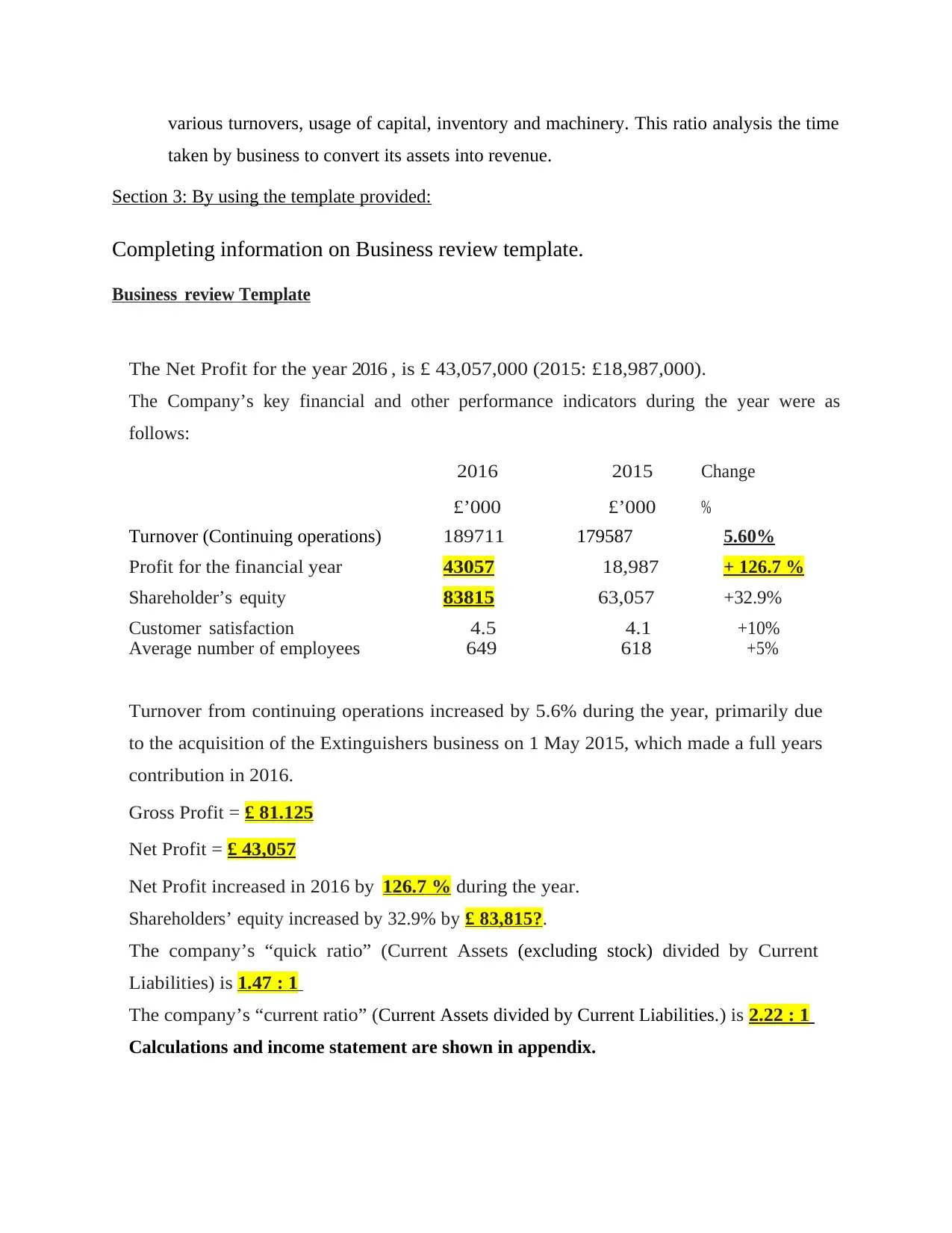
various turnovers, usage of capital, inventory and machinery. This ratio analysis the time
taken by business to convert its assets into revenue.
Section 3: By using the template provided:
Completing information on Business review template.
Business review Template
The Net Profit for the year 2016 , is £ 43,057,000 (2015: £18,987,000).
The Company’s key financial and other performance indicators during the year were as
follows:
2016
£’000
2015
£’000
Change
%
Turnover (Continuing operations) 189711 179587 5.60%
Profit for the financial year 43057 18,987 + 126.7 %
Shareholder’s equity 83815 63,057 +32.9%
Customer satisfaction 4.5 4.1 +10%
Average number of employees 649 618 +5%
Turnover from continuing operations increased by 5.6% during the year, primarily due
to the acquisition of the Extinguishers business on 1 May 2015, which made a full years
contribution in 2016.
Gross Profit = £ 81.125
Net Profit = £ 43,057
Net Profit increased in 2016 by 126.7 % during the year.
Shareholders’ equity increased by 32.9% by £ 83,815?.
The company’s “quick ratio” (Current Assets (excluding stock) divided by Current
Liabilities) is 1.47 : 1
The company’s “current ratio” (Current Assets divided by Current Liabilities. ) is 2.22 : 1
Calculations and income statement are shown in appendix.
taken by business to convert its assets into revenue.
Section 3: By using the template provided:
Completing information on Business review template.
Business review Template
The Net Profit for the year 2016 , is £ 43,057,000 (2015: £18,987,000).
The Company’s key financial and other performance indicators during the year were as
follows:
2016
£’000
2015
£’000
Change
%
Turnover (Continuing operations) 189711 179587 5.60%
Profit for the financial year 43057 18,987 + 126.7 %
Shareholder’s equity 83815 63,057 +32.9%
Customer satisfaction 4.5 4.1 +10%
Average number of employees 649 618 +5%
Turnover from continuing operations increased by 5.6% during the year, primarily due
to the acquisition of the Extinguishers business on 1 May 2015, which made a full years
contribution in 2016.
Gross Profit = £ 81.125
Net Profit = £ 43,057
Net Profit increased in 2016 by 126.7 % during the year.
Shareholders’ equity increased by 32.9% by £ 83,815?.
The company’s “quick ratio” (Current Assets (excluding stock) divided by Current
Liabilities) is 1.47 : 1
The company’s “current ratio” (Current Assets divided by Current Liabilities. ) is 2.22 : 1
Calculations and income statement are shown in appendix.
⊘ This is a preview!⊘
Do you want full access?
Subscribe today to unlock all pages.

Trusted by 1+ million students worldwide
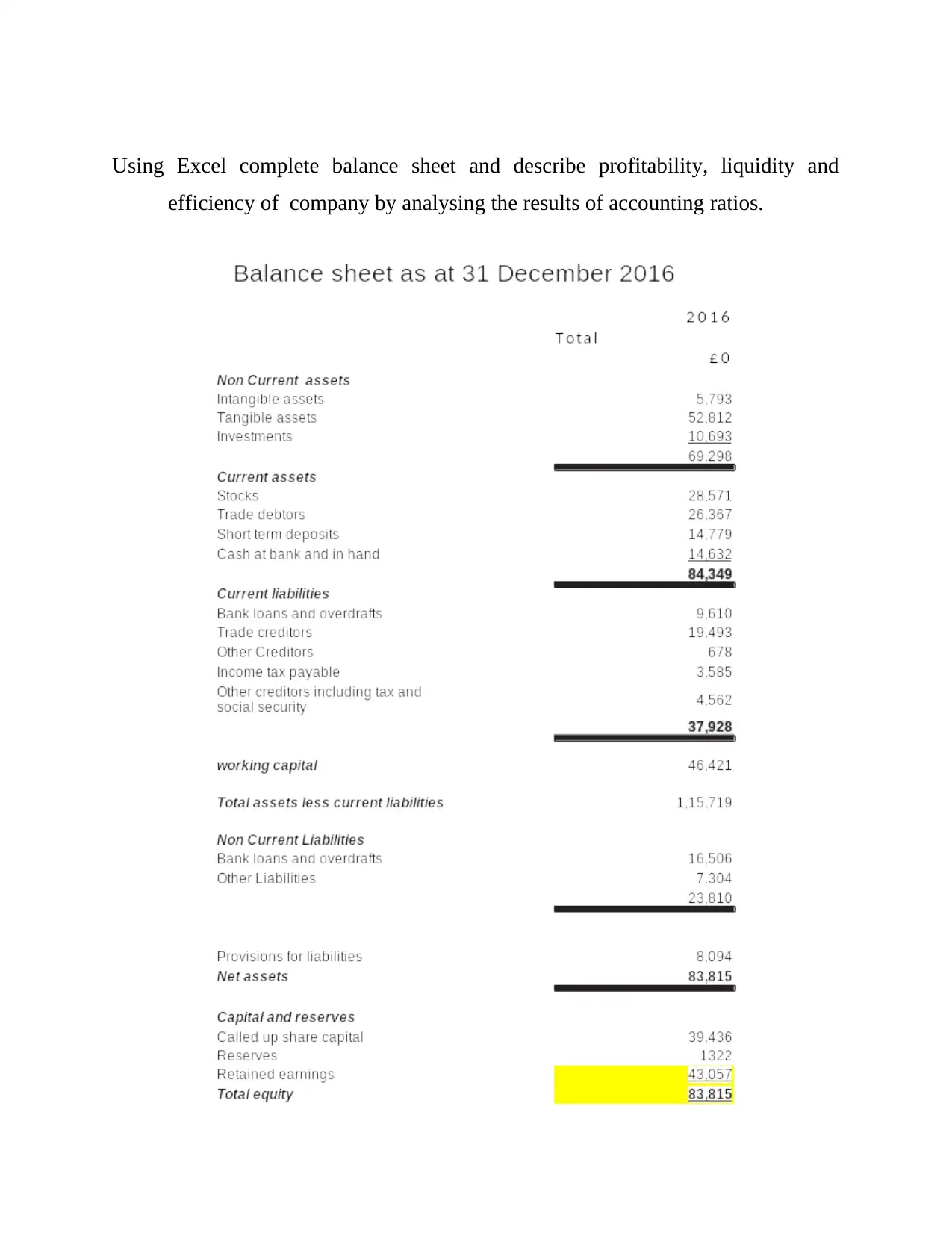
Using Excel complete balance sheet and describe profitability, liquidity and
efficiency of company by analysing the results of accounting ratios.
efficiency of company by analysing the results of accounting ratios.
Paraphrase This Document
Need a fresh take? Get an instant paraphrase of this document with our AI Paraphraser
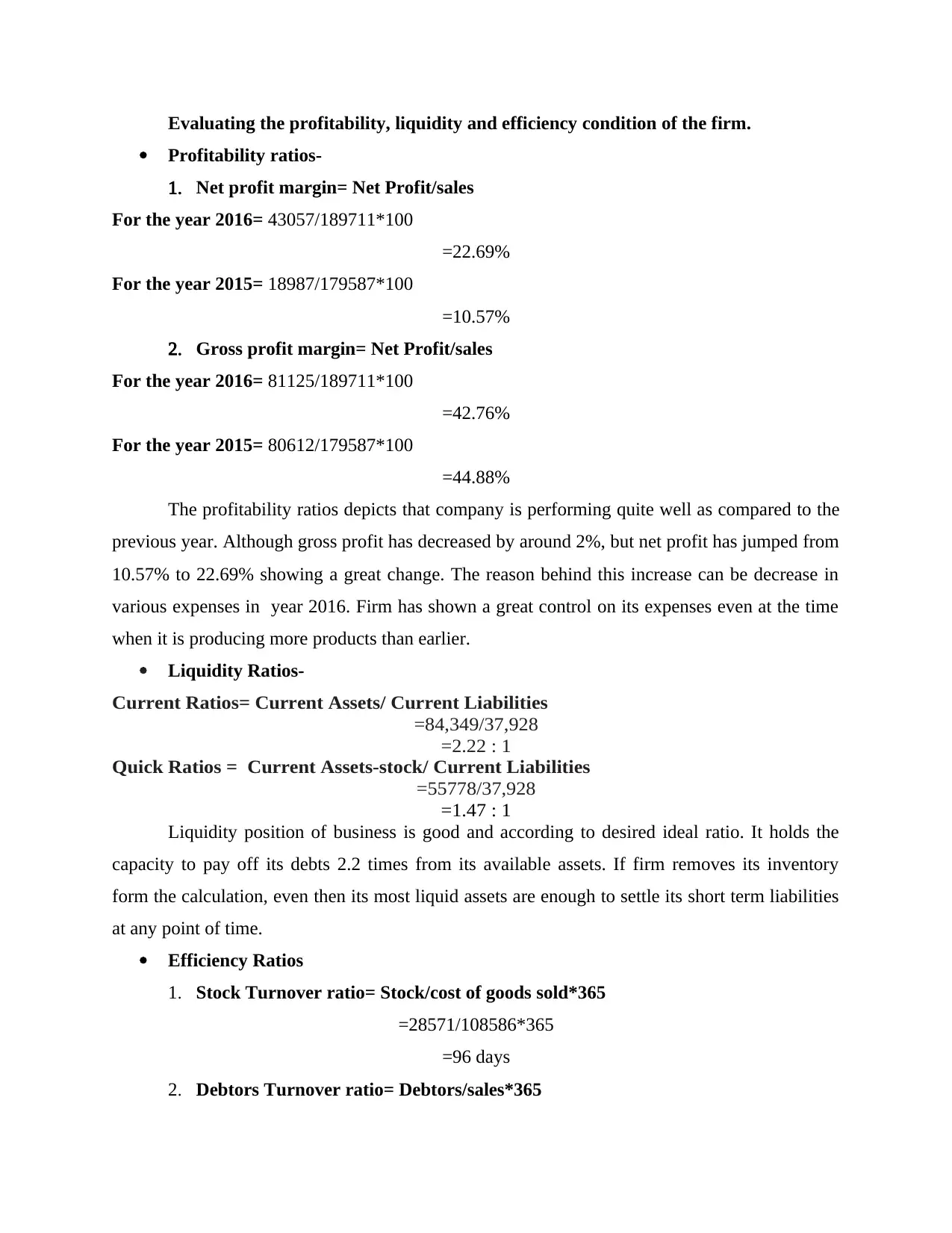
Evaluating the profitability, liquidity and efficiency condition of the firm.
Profitability ratios-
1. Net profit margin= Net Profit/sales
For the year 2016= 43057/189711*100
=22.69%
For the year 2015= 18987/179587*100
=10.57%
2. Gross profit margin= Net Profit/sales
For the year 2016= 81125/189711*100
=42.76%
For the year 2015= 80612/179587*100
=44.88%
The profitability ratios depicts that company is performing quite well as compared to the
previous year. Although gross profit has decreased by around 2%, but net profit has jumped from
10.57% to 22.69% showing a great change. The reason behind this increase can be decrease in
various expenses in year 2016. Firm has shown a great control on its expenses even at the time
when it is producing more products than earlier.
Liquidity Ratios-
Current Ratios= Current Assets/ Current Liabilities
=84,349/37,928
=2.22 : 1
Quick Ratios = Current Assets-stock/ Current Liabilities
=55778/37,928
=1.47 : 1
Liquidity position of business is good and according to desired ideal ratio. It holds the
capacity to pay off its debts 2.2 times from its available assets. If firm removes its inventory
form the calculation, even then its most liquid assets are enough to settle its short term liabilities
at any point of time.
Efficiency Ratios
1. Stock Turnover ratio= Stock/cost of goods sold*365
=28571/108586*365
=96 days
2. Debtors Turnover ratio= Debtors/sales*365
Profitability ratios-
1. Net profit margin= Net Profit/sales
For the year 2016= 43057/189711*100
=22.69%
For the year 2015= 18987/179587*100
=10.57%
2. Gross profit margin= Net Profit/sales
For the year 2016= 81125/189711*100
=42.76%
For the year 2015= 80612/179587*100
=44.88%
The profitability ratios depicts that company is performing quite well as compared to the
previous year. Although gross profit has decreased by around 2%, but net profit has jumped from
10.57% to 22.69% showing a great change. The reason behind this increase can be decrease in
various expenses in year 2016. Firm has shown a great control on its expenses even at the time
when it is producing more products than earlier.
Liquidity Ratios-
Current Ratios= Current Assets/ Current Liabilities
=84,349/37,928
=2.22 : 1
Quick Ratios = Current Assets-stock/ Current Liabilities
=55778/37,928
=1.47 : 1
Liquidity position of business is good and according to desired ideal ratio. It holds the
capacity to pay off its debts 2.2 times from its available assets. If firm removes its inventory
form the calculation, even then its most liquid assets are enough to settle its short term liabilities
at any point of time.
Efficiency Ratios
1. Stock Turnover ratio= Stock/cost of goods sold*365
=28571/108586*365
=96 days
2. Debtors Turnover ratio= Debtors/sales*365
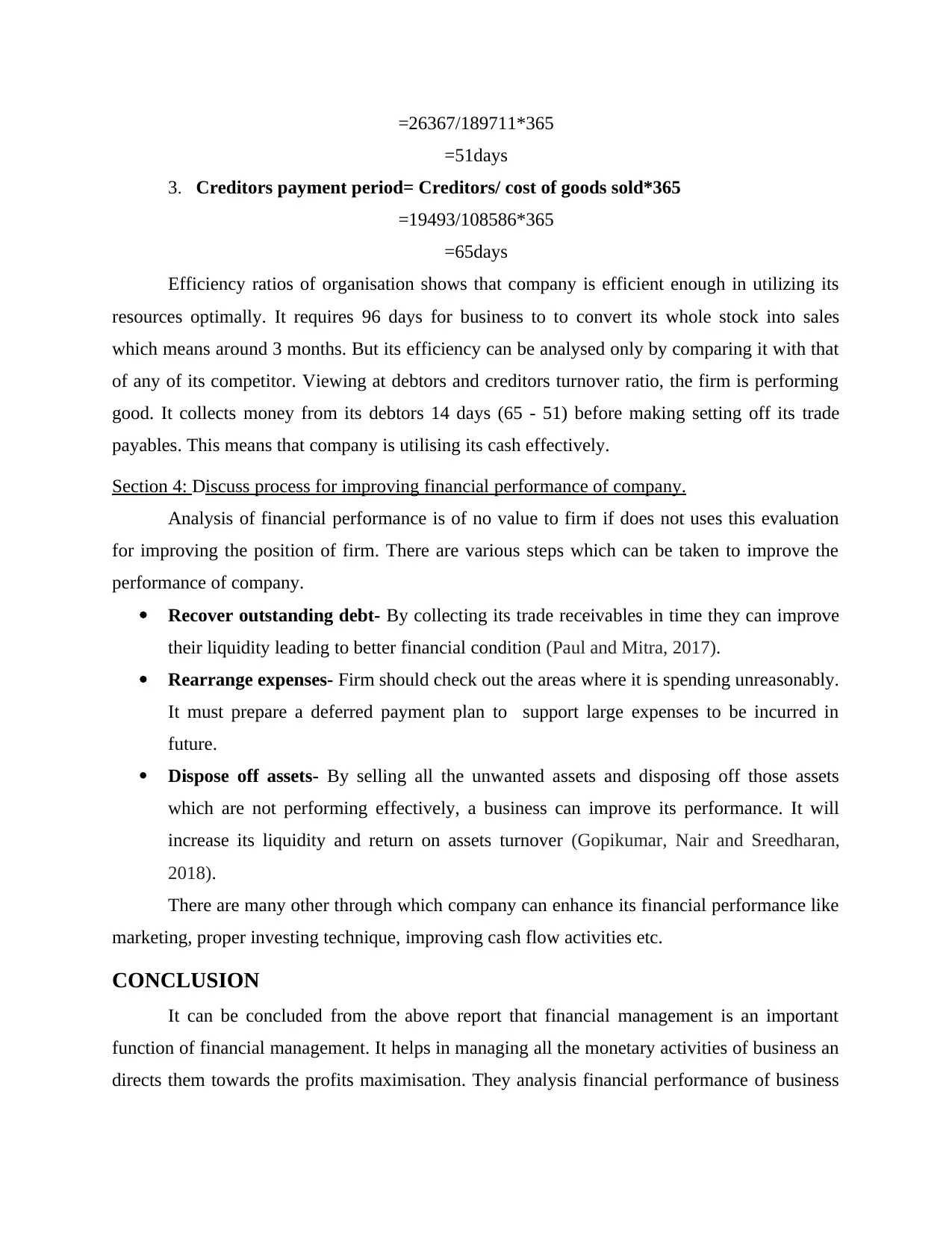
=26367/189711*365
=51days
3. Creditors payment period= Creditors/ cost of goods sold*365
=19493/108586*365
=65days
Efficiency ratios of organisation shows that company is efficient enough in utilizing its
resources optimally. It requires 96 days for business to to convert its whole stock into sales
which means around 3 months. But its efficiency can be analysed only by comparing it with that
of any of its competitor. Viewing at debtors and creditors turnover ratio, the firm is performing
good. It collects money from its debtors 14 days (65 - 51) before making setting off its trade
payables. This means that company is utilising its cash effectively.
Section 4: Discuss process for improving financial performance of company.
Analysis of financial performance is of no value to firm if does not uses this evaluation
for improving the position of firm. There are various steps which can be taken to improve the
performance of company.
Recover outstanding debt- By collecting its trade receivables in time they can improve
their liquidity leading to better financial condition (Paul and Mitra, 2017).
Rearrange expenses- Firm should check out the areas where it is spending unreasonably.
It must prepare a deferred payment plan to support large expenses to be incurred in
future.
Dispose off assets- By selling all the unwanted assets and disposing off those assets
which are not performing effectively, a business can improve its performance. It will
increase its liquidity and return on assets turnover (Gopikumar, Nair and Sreedharan,
2018).
There are many other through which company can enhance its financial performance like
marketing, proper investing technique, improving cash flow activities etc.
CONCLUSION
It can be concluded from the above report that financial management is an important
function of financial management. It helps in managing all the monetary activities of business an
directs them towards the profits maximisation. They analysis financial performance of business
=51days
3. Creditors payment period= Creditors/ cost of goods sold*365
=19493/108586*365
=65days
Efficiency ratios of organisation shows that company is efficient enough in utilizing its
resources optimally. It requires 96 days for business to to convert its whole stock into sales
which means around 3 months. But its efficiency can be analysed only by comparing it with that
of any of its competitor. Viewing at debtors and creditors turnover ratio, the firm is performing
good. It collects money from its debtors 14 days (65 - 51) before making setting off its trade
payables. This means that company is utilising its cash effectively.
Section 4: Discuss process for improving financial performance of company.
Analysis of financial performance is of no value to firm if does not uses this evaluation
for improving the position of firm. There are various steps which can be taken to improve the
performance of company.
Recover outstanding debt- By collecting its trade receivables in time they can improve
their liquidity leading to better financial condition (Paul and Mitra, 2017).
Rearrange expenses- Firm should check out the areas where it is spending unreasonably.
It must prepare a deferred payment plan to support large expenses to be incurred in
future.
Dispose off assets- By selling all the unwanted assets and disposing off those assets
which are not performing effectively, a business can improve its performance. It will
increase its liquidity and return on assets turnover (Gopikumar, Nair and Sreedharan,
2018).
There are many other through which company can enhance its financial performance like
marketing, proper investing technique, improving cash flow activities etc.
CONCLUSION
It can be concluded from the above report that financial management is an important
function of financial management. It helps in managing all the monetary activities of business an
directs them towards the profits maximisation. They analysis financial performance of business
⊘ This is a preview!⊘
Do you want full access?
Subscribe today to unlock all pages.

Trusted by 1+ million students worldwide
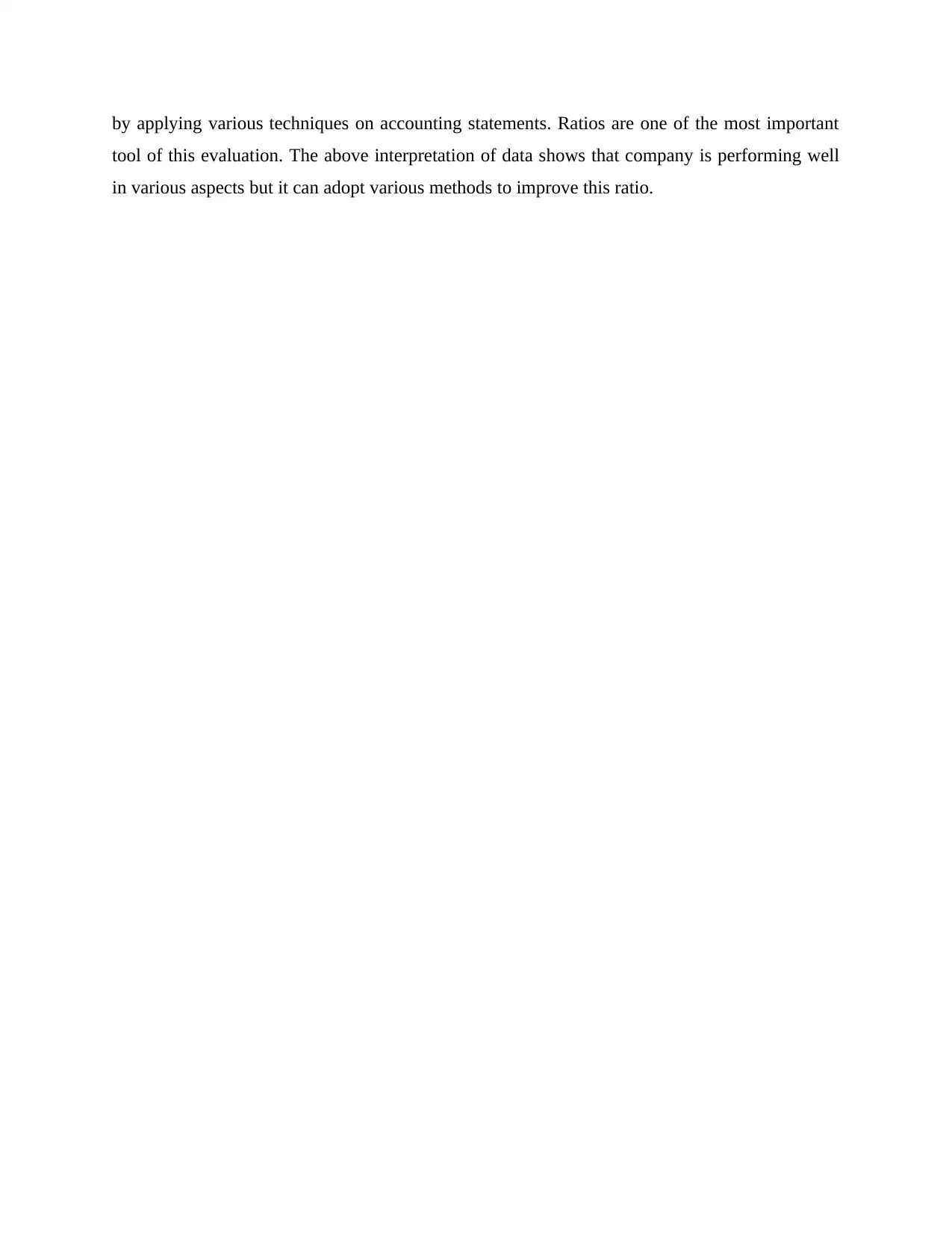
by applying various techniques on accounting statements. Ratios are one of the most important
tool of this evaluation. The above interpretation of data shows that company is performing well
in various aspects but it can adopt various methods to improve this ratio.
tool of this evaluation. The above interpretation of data shows that company is performing well
in various aspects but it can adopt various methods to improve this ratio.
Paraphrase This Document
Need a fresh take? Get an instant paraphrase of this document with our AI Paraphraser
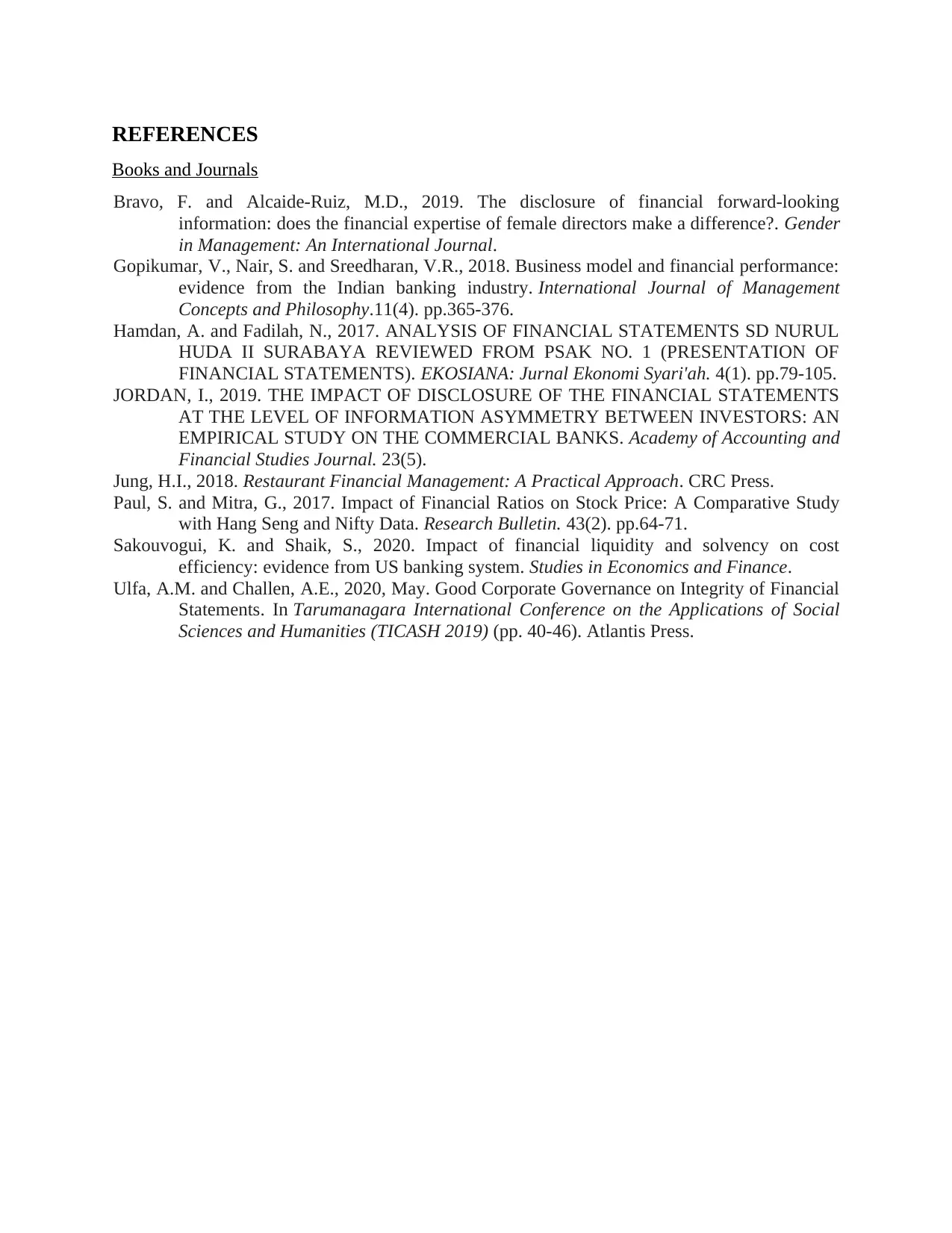
REFERENCES
Books and Journals
Bravo, F. and Alcaide-Ruiz, M.D., 2019. The disclosure of financial forward-looking
information: does the financial expertise of female directors make a difference?. Gender
in Management: An International Journal.
Gopikumar, V., Nair, S. and Sreedharan, V.R., 2018. Business model and financial performance:
evidence from the Indian banking industry. International Journal of Management
Concepts and Philosophy.11(4). pp.365-376.
Hamdan, A. and Fadilah, N., 2017. ANALYSIS OF FINANCIAL STATEMENTS SD NURUL
HUDA II SURABAYA REVIEWED FROM PSAK NO. 1 (PRESENTATION OF
FINANCIAL STATEMENTS). EKOSIANA: Jurnal Ekonomi Syari'ah. 4(1). pp.79-105.
JORDAN, I., 2019. THE IMPACT OF DISCLOSURE OF THE FINANCIAL STATEMENTS
AT THE LEVEL OF INFORMATION ASYMMETRY BETWEEN INVESTORS: AN
EMPIRICAL STUDY ON THE COMMERCIAL BANKS. Academy of Accounting and
Financial Studies Journal. 23(5).
Jung, H.I., 2018. Restaurant Financial Management: A Practical Approach. CRC Press.
Paul, S. and Mitra, G., 2017. Impact of Financial Ratios on Stock Price: A Comparative Study
with Hang Seng and Nifty Data. Research Bulletin. 43(2). pp.64-71.
Sakouvogui, K. and Shaik, S., 2020. Impact of financial liquidity and solvency on cost
efficiency: evidence from US banking system. Studies in Economics and Finance.
Ulfa, A.M. and Challen, A.E., 2020, May. Good Corporate Governance on Integrity of Financial
Statements. In Tarumanagara International Conference on the Applications of Social
Sciences and Humanities (TICASH 2019) (pp. 40-46). Atlantis Press.
Books and Journals
Bravo, F. and Alcaide-Ruiz, M.D., 2019. The disclosure of financial forward-looking
information: does the financial expertise of female directors make a difference?. Gender
in Management: An International Journal.
Gopikumar, V., Nair, S. and Sreedharan, V.R., 2018. Business model and financial performance:
evidence from the Indian banking industry. International Journal of Management
Concepts and Philosophy.11(4). pp.365-376.
Hamdan, A. and Fadilah, N., 2017. ANALYSIS OF FINANCIAL STATEMENTS SD NURUL
HUDA II SURABAYA REVIEWED FROM PSAK NO. 1 (PRESENTATION OF
FINANCIAL STATEMENTS). EKOSIANA: Jurnal Ekonomi Syari'ah. 4(1). pp.79-105.
JORDAN, I., 2019. THE IMPACT OF DISCLOSURE OF THE FINANCIAL STATEMENTS
AT THE LEVEL OF INFORMATION ASYMMETRY BETWEEN INVESTORS: AN
EMPIRICAL STUDY ON THE COMMERCIAL BANKS. Academy of Accounting and
Financial Studies Journal. 23(5).
Jung, H.I., 2018. Restaurant Financial Management: A Practical Approach. CRC Press.
Paul, S. and Mitra, G., 2017. Impact of Financial Ratios on Stock Price: A Comparative Study
with Hang Seng and Nifty Data. Research Bulletin. 43(2). pp.64-71.
Sakouvogui, K. and Shaik, S., 2020. Impact of financial liquidity and solvency on cost
efficiency: evidence from US banking system. Studies in Economics and Finance.
Ulfa, A.M. and Challen, A.E., 2020, May. Good Corporate Governance on Integrity of Financial
Statements. In Tarumanagara International Conference on the Applications of Social
Sciences and Humanities (TICASH 2019) (pp. 40-46). Atlantis Press.
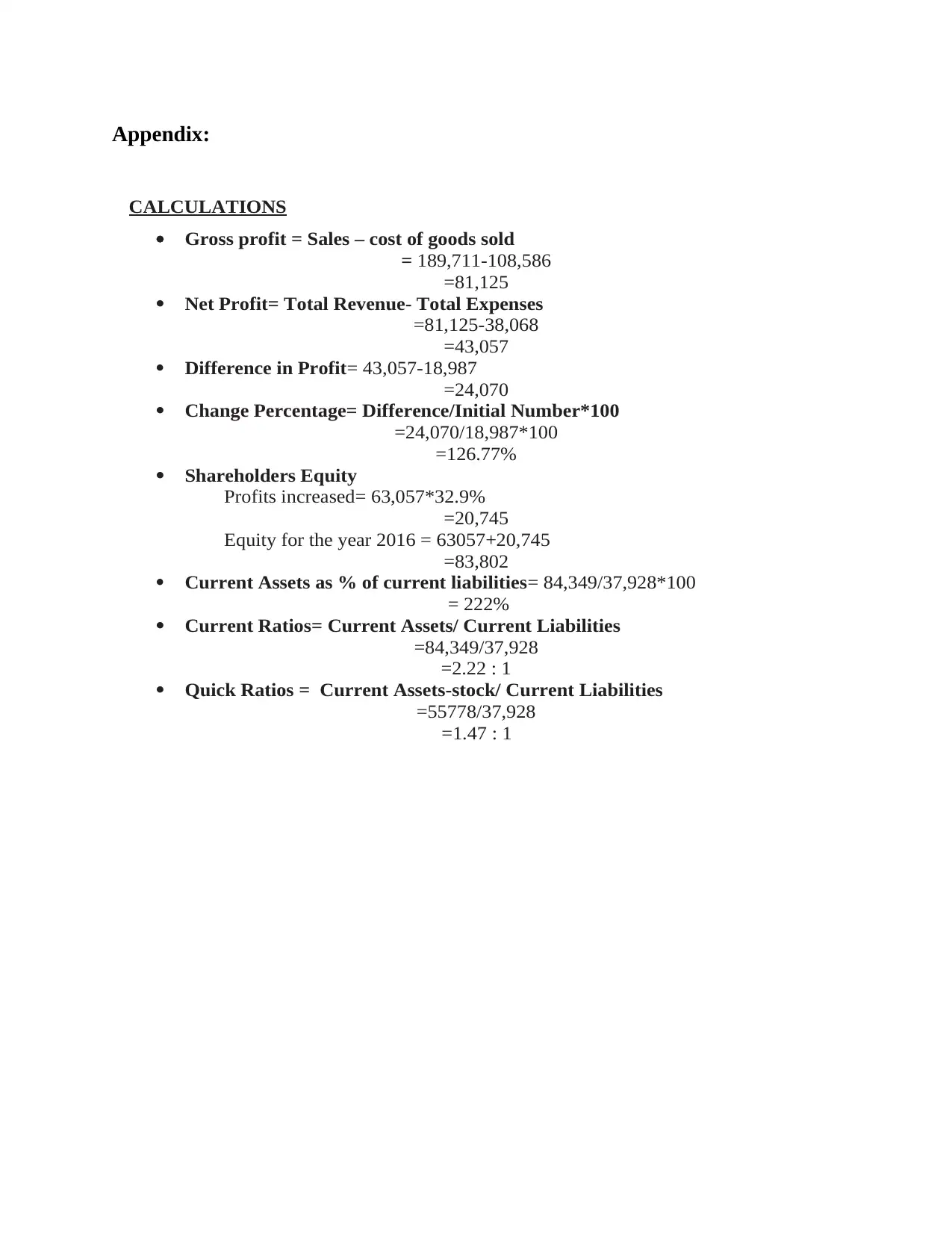
Appendix:
CALCULATIONS
Gross profit = Sales – cost of goods sold
= 189,711-108,586
=81,125
Net Profit= Total Revenue- Total Expenses
=81,125-38,068
=43,057
Difference in Profit= 43,057-18,987
=24,070
Change Percentage= Difference/Initial Number*100
=24,070/18,987*100
=126.77%
Shareholders Equity
Profits increased= 63,057*32.9%
=20,745
Equity for the year 2016 = 63057+20,745
=83,802
Current Assets as % of current liabilities= 84,349/37,928*100
= 222%
Current Ratios= Current Assets/ Current Liabilities
=84,349/37,928
=2.22 : 1
Quick Ratios = Current Assets-stock/ Current Liabilities
=55778/37,928
=1.47 : 1
CALCULATIONS
Gross profit = Sales – cost of goods sold
= 189,711-108,586
=81,125
Net Profit= Total Revenue- Total Expenses
=81,125-38,068
=43,057
Difference in Profit= 43,057-18,987
=24,070
Change Percentage= Difference/Initial Number*100
=24,070/18,987*100
=126.77%
Shareholders Equity
Profits increased= 63,057*32.9%
=20,745
Equity for the year 2016 = 63057+20,745
=83,802
Current Assets as % of current liabilities= 84,349/37,928*100
= 222%
Current Ratios= Current Assets/ Current Liabilities
=84,349/37,928
=2.22 : 1
Quick Ratios = Current Assets-stock/ Current Liabilities
=55778/37,928
=1.47 : 1
⊘ This is a preview!⊘
Do you want full access?
Subscribe today to unlock all pages.

Trusted by 1+ million students worldwide
1 out of 13
Related Documents
Your All-in-One AI-Powered Toolkit for Academic Success.
+13062052269
info@desklib.com
Available 24*7 on WhatsApp / Email
![[object Object]](/_next/static/media/star-bottom.7253800d.svg)
Unlock your academic potential
Copyright © 2020–2025 A2Z Services. All Rights Reserved. Developed and managed by ZUCOL.

